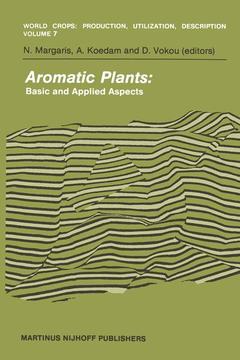Description
Aromatic Plants, Softcover reprint of the original 1st ed. 1982
Basic and Applied Aspects
World Crops: Production, Utilization and Description Series, Vol. 7
Language: English
Subject for Aromatic Plants:
Keywords
NMR; anatomy; arctic; aromatic; distribution; ecology; electron microscopy; influence; microscopy; morphology; pharmacology; plant; plants; structure; taxonomy
Publication date: 11-2011
283 p. · 16x24 cm · Paperback
283 p. · 16x24 cm · Paperback
Description
/li>Contents
/li>
The use of aromatic plants has been practised since ancient times as is evidenced by records of Chinese, Egyptian, Mesopotamian, Greek and Roman origin; recent findings in Pakistan prove that it goes as far back as 5000 years. Accordingly, the importance and value ascribed to them were always high. Either as a medicine, a foodstuff, a seasoning, a cosmetic or an element of religious rituals the aromatic plant was indispensable. It is not to be forgotten that desire tor the riches of India - spices among which - and the struggle to monopolize the trade of the latter con tributed to the opening of new sea routes, discovering of continents and altering the picture of the known world. With the advent of modern civilization, characterized by scientific and technological development which dIverted estimation and consumption towards artificial products, aromatic plants experienced a temporary de cline of use retaining, however, theIr importance In sectors such as the culinary art and cosmetics industry.
1 — Anatomy and Morphology.- - Ultrastructure of the essential oil secretion in glandular scales of Origanum dictamnus L. leaves.- - Leaf morphology of Thymus capitatus (Labiatae) by scanning electron microscopy.- - Inula hairs — Structure, ultrastructure and secretion.- - Pollen morphology of the genus Origanum L. and allied genera.- 2 — Ecology and Distribution.- - Volatile oils as allelopathic agents.- - Artemisia tridentata monoterpenoid effect on ruminant digestion and forage selection.- - Productivity of aromatic plants: climatic models.- - A taxonomic revision of Sideritis L. section Empedoclia (Rafin.) Bentham (Labiatae) in Greece.- 3 — Chemotaxonomy.- - Morphological, cytological and chemical investigations of Mentha spicata L. in Greece.- - Distribution of flavonoids as chemotaxonomic markers in the genus Origanum L. and related genera in Labiatae.- - New chemical markers within Artemisia (Compositae-Anthemidae).- - Chemical investigations of essential oils of Umbellifers.- 4 — Analysis and Composition.- - 13C-NMR analysis of essential oils.- - Qualitative evaluation of aromatic herbs by direct space (GC)2 analysis. Application of the method and comparison with the traditional analysis of essential oils.- - The chemical composition of the essential oil obtained from Satureja kitaibelii Wierzb. ap. Heuff..- - The essential oil from Thymus praecox ssp. arcticus.- - Atractylodes lancea DC. (Compositae). Contribution on the constituents of the essential oil..- - Chemotaxonomy of the Greek species of Sideritis. I. Components of the volatile fraction of Sideritis raeseri ssp. raeseri.- - The terpenes of the essential oil of myrrh.- 5 — Production and Application.- - The influence of some distillation conditions on essential oil composition.- - Variationsin yield parameters in a wild population of Origanum vulgare.- - The production of aromatic plants in the Pancalieri area.- - Some potentially important indigenous aromatic plants from the eastern seaboard areas of Southern Africa.- - Labiatae as medicinal plants in Israel.- - New pharmacologically important flavonoids of Thymus vulgaris.- Plant Systematic Index.- Chemical Index.
© 2024 LAVOISIER S.A.S.




